Contents
- 1.1 Guidelines for Choosing a Market
- 1.2 Feeder Pig Marketing Techniques
- 1.3 Price, Demand, Supply Structure
- 1.4 Sources of price information
- 1.5 Formula pricing
- 1.6 Factors to keep in mind when considering pricing formulas are:
- 1.7 Guidelines for Selling Feeder Pigs
- 1.8 Implications of Modified Medicated Early Weaning and Isowean® Technology
- 1.9 Co-op Feeder Pig Production/Marketing
- 1.10 Grade
- 1.11 TABLES
Originally published as PIH-72.
Authors:
Dennis DiPietre, University of Missouri;
Ronald L. Plain, University of Missouri;
Ted Schroeder, Kansas State University
Roderick C. Tubbs, University of Missouri
Reviewers:
Gene and Teresa Cooper, LaCenter Kentucky;
Palmer Holden, Iowa State University;
Allan Lines, The Ohio State University
As the pork industry undergoes consolidation, the feeder pig production and marketing functions are experiencing tremendous change. Producers of feeder pigs are rapidly declining while sales of feeder pigs have remained relatively constant indicating producers are getting larger. As consumer’s preferences change, packers in turn are signalling pork producers through their pricing systems that a high-quality, consistent and lean animal will receive significant premiums at the plant. This in turn places increasing pressures on feeder pig producers to improve quality, uniformity and overall health status of their output. Marketing high-quality, uniform and healthy feeder pigs in sufficient volume will be required of producers to be competitive as we enter the twenty-first century. Marketing methods will continue to change rapidly in the next several years. Interdependence and cooperative production and marketing associations will likely increase as producers respond to changing market structures and requirements.
Guidelines for Choosing a Market
The following factors should be considered in selecting a market for feeder pigs The market or selling agency should:
- recognize and reward quality, uniformity and health status
- accurately assess (grade) quality
- provide a means to accurately determine a fair, competitive price
- provide an accurate, government-tested scale weight
- provide timely and accurate accounting and guaranteed payment
- provide a physical environment which preserves the quality of the pigs
- provide a means to inspect, or receive accurate information about the pigs
Feeder Pig Marketing Techniques
Currently, methods of marketing feeder pigs vary by region. Techniques range from decentralized direct sales between individual feeder pig producers and finishers to more centralized, sophisticated electronic markets. Each method offers unique circumstances and challenges for the feeder pig producer and/or buyer. The most prevalent marketing methods include the following:
Direct feeder pig producer to feeder pig finisher
The producer may advertise feeder pigs locally to attract interested buyers or the producer may develop long term supply relationships with one or more buyers. Price is generally negotiated and, in instances of longer term contractual arrangements, may be established using an agreed upon formula price. These formulas often are based on a nearby or benchmark public price. Determining a fair formula can be difficult, especially if the quality of the pigs being sold differs substantially from the average at the public markets. Many public markets no longer report prices. Both sellers and buyers need to be informed of market conditions and have a means to determine the economic value of the pigs in order to settle upon a fair price.
Public auction
A producer brings or consigns pigs to the livestock auction operated by a firm or farmer owned marketing cooperative. Pigs may be sold as delivered or graded and pooled for sale to buyers. Pigs graded into uniform-graded lots are attractive to buyers. Pigs are sold to the highest bidder and price depends upon buyer demand. Generally, once pigs enter the sale ring they are sold without opportunity for withdrawal by the seller.
Electronic auction
Electronic auction selling has gained increased popularity in recent years with the opening of an electronic auction by Central Livestock Association in St. Paul, Minnesota. Prospective feeder pig sellers’ herds are health inspected and the seller is certified by the auction association. Feeder pigs offered for sale are scored based on health programs, feeding programs, and herd management. This information along with the identification of the seller is made available to prospective buyers via computer modems. Consigned feeder pigs can be reviewed by potential buyers who then participate in an open auction as each pen is offered for sale. No commingling or central collection of the feeder pigs occurs. Pigs move directly from the seller to the buyer. For a consignment fee sellers reserve the right to withdraw pigs from the auction and declare a no sell. Likewise, feeder pigs that are not accurately represented or do not meet weight and grade specifications are either price adjusted at delivery or may be rejected in extreme circumstances by the buyer. Credit checks are run on buyers to insure payment. This market potentially expands the number and geographic dispersion of both sellers and buyers relative to other market alternatives. Feeder pig producers considering this type of market should closely investigate the process and clauses for the particular market they are investigating. This marketing method offers potential benefits to both buyers and sellers if properly designed and operated.
Price, Demand, Supply Structure
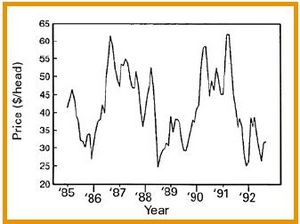
Feeder pig prices are volatile, reacting to numerous economic factors. Figure 1 shows the monthly average price pattern of feeder pigs from 1985 through September 1992. In relatively short periods feeder pig prices vary from less than $30/head to more than $60/head. This price variability confers considerable risk to both feeder pig producers and buyers. The observed price fluctuations are a result of changes in demand for and/or supply of feeder pigs.
Feeder pig supply is determined by sow farrowings and weaned litter size. The higher the farrowings, all else constant, the more feeder pigs that will be available and the lower the feeder pig price. Information on sow farrowing intentions and actual sow farrowings are reported in the USDA quarterly Hogs and Pigs report. This report is released in March, June, September, and early January (December report). Once farrowings have
occurred, feeder pig supplies are essentially determined and price will be driven primarily by feeder pig demand factors.
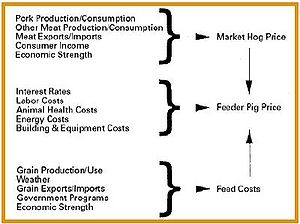
Primary determinants of feeder pig prices are shown in Figure 2. Feeder pig demand is influenced by numerous factors. Profit expectations of feeder pig buyers will be the major pricing factor. Expected market hog prices at the time the feeder pigs will be slaughtered are the most important consideration. The live hog futures price for contracts maturing near the expected slaughter hog marketing date serve as an expectation of future cash slaughter hog market price levels.
Thus, increases in deferred live hog futures prices generally signal increased cash feeder pig prices. Any economic factor that affects market hog prices, including pork production, production of competing meats, meat exports and imports, consumer income, and strength of economy exert indirect influences on feeder pig prices.
The second most important factor affecting feeder pig demand and prices is feeding costs. Feeding costs are affected both by the cost of the feed itself and the efficiency with which the animal can turn these inputs into saleable pork. Increases in feeding costs reduce feeder pig demand driving prices down. As a result, weather affecting feed grain and soybean meal prices can have dramatic influences on feeder pig prices. Characteristics of the pig itself, such as its genetics and health status plus the environment within which the pig will be finished, also affect feeding costs and thereby feeder pig prices. Other costs of feeder pig finishing, including interest rates, labor costs, routine health costs, energy costs, and building and equipment costs also affect feeder pig prices. One method to project the expected influence of changes in feed costs and expected slaughter hog prices on feeder pig prices is to develop feeder pig finishing budgets to determine break-even feeder pig purchase prices for different feeding costs and slaughter hog prices. Actual feeder pig prices usually follow break-even prices (perhaps with a profit adjustment).
Feeder pig markets also vary by region. Local weather, crop conditions, farm financial conditions, and slaughter hog market access should be monitored as they may affect local feeder pig prices. Figures 3 through 7 graphically illustrate information about feeder pig prices.
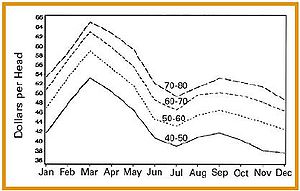
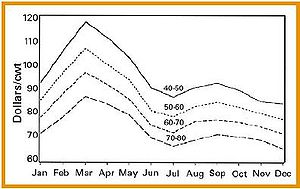

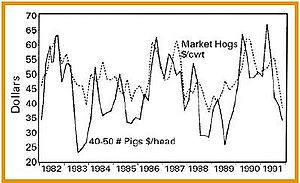
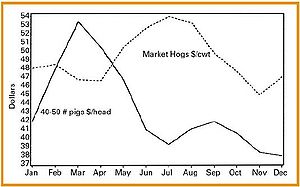
Sources of price information
Daily feeder pig price information is limited in many regions. Producers often must rely on weekly auction quotations, terminal market sale reports, cooperative market reports, releases from agribusiness firms, electronic wire service reports, and periodic government releases. The percentage of feeder pigs being marketed directly from feeder pig producer to hog finisher in private treaties reduces the availability and, therefore, representativeness of feeder pig price data. Feeder pig prices usually are quoted on a per head basis or occasionally on per hundredweight (cwt) basis. Interpretation of price reports requires understanding the market conditions, location, terms of the sale, grade standards, number of pigs represented by price quote, feeder pig quality, and preconditioning and vaccination backgrounds of the pigs.
The USDA publication Livestock, Meat, Wool Market News contains price quotes from a number of feeder pig markets around the country. Subscription information for this weekly publication can be obtained from USDA Livestock & Grain Market News, Room 2623-S, P.O. Box 96456, Washington, D.C. 20090-6456.
Formula pricing
As an alternative to using a competitive bid, some feeder pig producers use a formula to establish the sale price for their pigs. Making a formula pricing system work is very difficult. Because of changing price relationships among slaughter hogs, hog futures, feed prices, interest rates and other production costs, formula prices will rarely exactly match market prices. When the formula price is below the market price, the pig seller often feels shortchanged. When the formula price is above the market, the pig buyer is likely to feel disadvantaged. For this reason, formula pricing works best when the feeder pig producer deals with the same buyer(s) over an extended period. The most successful formulas are those based on an established feeder pig market. Some suggested price formulas for feeder pigs:
- Formula 1: The price per head = $2 under the top price for comparable weight feeder pigs at a designated market
- Formula 2: The price per cwt = $3 over the average price for comparable weight pigs at a designated market
- Formula 3: The price per head for a 45 pound pig = 2 times hog/corn ratio
- Formula 4: The price per head for a 40 pound pig = market hog price/cwt minus the price of 4 bushels of corn
- Formula 5: The price per cwt for a 45 pound pig = 2 times the live hog futures price for hogs minus $4.
- Formula 6: The price per cwt = market hog price times the two factors (one for pig weight and one for season) from the table at right:
Factors to keep in mind when considering pricing formulas are:
- Feeder pig prices are highly variable and fluctuate more from pig to pig and location to location than do market hog prices.
- Price formulas are only general price indicators and work best when hog and feed prices are in normal ranges.
- Price formulas work best on average pigs. Most formulas make no adjustment for location, pig quality or lot size.
- Price formulas work well on average. At any point in time, there may be considerable difference between the market price and the formula price.
Guidelines for Selling Feeder Pigs
Selling to an individual buyer
Historically, most feeder pig producers have been able to rely upon organized public markets as an option for selling some or all of their pigs. For a variety of reasons, the number of organized feeder pig auctions has declined greatly in the last decade and is likely to continue to dwindle. This means that direct sales to finishers may be the only option available to many feeder pig producers in the future. Direct sales place importance upon lot size, pig uniformity, genetics and health status. It is clear that feeder pig buyers place a significant premium upon large lots of uniform pigs from a single producer. Selling feeder pigs to an individual buyer allows the seller to work with the buyer to refine and customize a health program to a buyer’s needs. The seller should work with the buyer and the buyer’s veterinarian to insure that the health status of the pigs delivered meets the demands of the buyer.
General Guidelines
- Provide healthy pigs of uniform size and quality. Remove the “bottom-sort” or “tail-enders” from the group. All-in, all-out nursery production is critical to overall disease control and helps with uniformity of pigs.
- Provide pigs with a narrow age spread (2 weeks or less). This helps reduce the transmission of disease organisms, especially respiratory diseases, from older to younger pigs.
- Pigs’ tails should be docked and male pigs castrated well in advance of delivery, so that they are healed by the time the buyer receives them. Pigs with physical defects, such as hernias or other blemishes, should not be delivered.
- Parasite control practices should be established in the seller’s breeding herd to insure the delivery of pigs free of internal and external parasites.
- The parent herd should have no history of Actinobacillus pleuropneumonia (APP) or swine dysentery. Pigs should ideally be free of pseudorabies (PRV), or status should be known. Some finishers do not discriminate severely against PRV positive pigs if they are free of other diseases. State laws vary on movement of PRV infected pigs.
- Pigs should be vaccinated for erysipelas. If the parent herd has a history, or if the buyer requests, atrophic rhinitis and APP vaccines may be necessary.
- The seller should be willing to supply herd history and background information to the buyer and the buyer’s veterinarian. A health certificate or inspection form should be supplied by the seller’s veterinarian.
Selling to a market
Most of the guidelines that apply to selling to an individual buyer apply to selling to a public market, except that usually the communication between seller and buyer is not practical, so a specific program cannot be developed. Most markets have general health requirements concerning weight range and physical appearance of pigs. Uniformity of pigs is still recommended but not critical since they will usually be sorted by weight and grade by market personnel. Most markets now require that pigs be from PRV-monitored herds before they will accept them for sale.
Implications of Modified Medicated Early Weaning and Isowean® Technology
Traditionally, feeder pigs have been sold, mixed, and transported at about 40 pounds of body weight or around 8 weeks of age. Mixing pigs at 3 weeks of age or less is superior from a health standpoint than mixing pigs later. Removing pigs from the parent herd at 3 weeks of age or less removes them from the primary source of exposure to infectious organisms (the sow herd) while they still have maternal antibodies (passive immunity) to protect them from many disease organisms. Research is underway to determine the specific logistics of transporting and housing young pigs that originate from several source herds. A heated, covered method of transportation and a modern, environmentally-controlled hot nursery are necessary. This technology may allow buyers to acquire pigs from more than one source without the severe disease consequences that sometimes occur when mixing 40lb pigs.
Co-op Feeder Pig Production/Marketing
As the pork production industry evolves, pressures for volume production of consistent, high quality pigs are resulting in the reemergence of cooperative feeder pig production. Commonly managed, several producers pool their resources to develop a feeder pig production site. Each producer may then claim one week’s (or some fraction of a week’s) production on a rotating basis with excess pigs (if available) contractually sold to third parties. Often a different site is obtained for the sow herd and nursery to take advantage of multiple site health benefits. Pigs may be formula priced to cooperative participants based on cost. Such an arrangement allows specialization, consistency and the exploitation of economies of size. This trend is expected to increase in the future.
Grade
USDA grading standards are available for feeder pig producers. Grade description can provide he uniform terminology for trading nationwide, using new communication technology and for accurate formula pricing. Some organizations modify the USDA standards to conform with their own grading systems. All grading standards attempt to relate the feeder pig to the final, finished quality of the animal. USDA grades include U.S. Numbers 1 through 4 and Utility. Additional information about USDA grades can be obtained from the Packers and Stockyards division of USDA or your local Cooperative Extension Office.
TABLES
Pig Wt Factor Pig Wt Factor
40lb 2.04 70lb 1.56
45lb 1.96 75lb 1.49
50lb 1.87 80lb 1.43
55lb 1.79 85lb 1.38
60lb 1.71 90lb 1.31
65lb 1.64 95lb 1.24
Month Factor Month Factor
Jan 0.99 Jul 0.82
Feb 1.12 Aug 0.87
Mar 1.30 Sep 0.95
Apr 1.23 Oct 0.96
May 1.05 Nov 0.97
Jun 0.88 Dec 0.91
